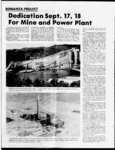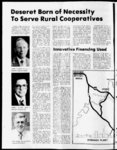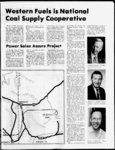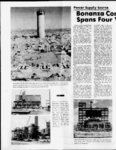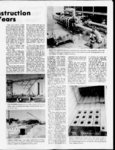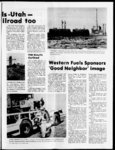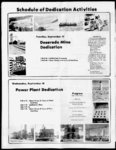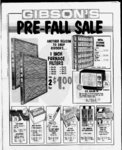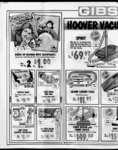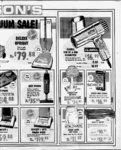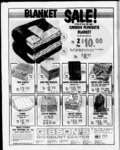| OCR Text |
Show To Provide Coal Wsflirin) IFy mdl IS Mam 21 12 above the track. This arrangement helps maintain the contact wire at the proper elevation and permits faster train speeds. Clean Coal Transportation Clean coal from the preparation plant is collected in a 150-tosurge bin and is fed by a e vibrating feeder onto the n 3.5-mil- long overland conveyor system for transport to a clean coal slot storage facility located t near the railroad system load-ou- loop. The overland conveyor has three belt flights. The two major sections measure about 9,000 and 7,000 feet. The steel-cabl- e belting is turned over at each transfer house and again 48-wi- at the tailpiece to keep the dirty of the belt up. This prevents coal spills along the belt line and keeps the return idlers free from coal build-up- . Carrying idlers are spaced on 8 centers and return idlers on 16 centers. side The final 1,480 section of belting terminates at the 25,000-tofacility. As n slot-storag- e massive as the building appears, most of it is underground. Inside are a series of pockets from whch coal is taken using a t control system in the facility. The coal moves by load-ou- conveyor into a loading hopper inside the loadout facility, over the tracks on which the Deseret-Wester- unit train n moves. Surface Operations to Clean and Move Coal The Deserado Mines surface facilities are dominated by the coal preparation plant and raw coal storage silos. The preparation plants jig and water-onlcyclone reduces the ash content of the coal, oroducine clean coal of 10,500 y Btus 10 percent ash, 12 percent moisture, and less than 0.5 percent sulfur. The circuit can handle up to 60 percent of 14 material All belt conveyor galleries are fine-co- Coal is Mined Underground Deserado Mine coal reserves are found in two major seams -the D seam and the deeper B seam. The coal miners are able to produce in a few months what Mine, abandoned Staley-Gordoproduced in all its years of operation. Initial operation of the Deserado Mine will produce 1.35 million tons of clean coal per thick D year from the seam. Eventually, another slope will be driven to gain access to the underlying B seam, which will set the stage for annual tons of production of clean coal per year. The production is tied to operation of the first unit .of the Bonanza Station. The tons production will not be needed until a second generation unit is added at the powerplant. The mine so far has operated one continuous miner section with one production and one maintenance shift per day. n full-scal- e 7.5-fo- n 1.35-millio- n Another continuous miner section will be added later this year. The crews are equipped with a Joy 12CM continuous miner, two Joy 10SC shuttle cars, a Lee-Nors- e twin-boo- roof feeder bolter, a Stamler breaker, Getman diesel mantrip carriers, an Eimco 913 diesel- - powered scoop, and Ford diesel fork lifts. A continuous miner uses a movable rotating drum to gouge coal from the operating face. A roof bolter is used to drive a resin-tippe- six-fo- bolt d through the mine roof and into strata above the coal. It provides hanging roof support in lieu of using wooden pillars to prop it. A feederbreaker is used to break up large chunks of coal and feeds it onto the conveyor system which carries it to the surface. Man-tricars and the other vehicles are used to move men and materials underground. Mine ventilation is provided k by a 400,000 cfm fan operating in an exhaust mode to pull fresh air through the mine and past the operating face where coal is being mined. Initial production using the single continuous miner section has been greater than expected, and is believed to be higher than comparable western area mines. Longwall equipment and additional continuous miner sections will be added later to meet production goals. Longwall equipment uses a long row of hydraulic roof supports working like jacks to hold up the roof and shield miners working underneath. An enormous shearing drum is used to strip away the entire seam of coal from mine floor to the roof as it passes down the row. As the shearer moves by, each hydraulic jack lowers momentarily, advances a step closer to the face, and raises again to support the roof. The coal falls onto a face conveyor. The roof is free to colapse behind the roof supports once they advance. enclosed and have walkways along both sides. belt, operating at a 14 degree angle, carries the coal from the mine to a 150-to- n surge hopper on the surface. The surge hopper is 54-wi- used to contain production already in the system in case surface operations cease for a time. A vibrating feeder sends coal by conveyor to a 10 by 20 rotary breaker which reduces it to chunks less than 4 in diameter before it is conveyed to the top of the two 10,000 ton raw coal silos. A shuttle conveyor can discharge the coal into either silo. The entire conveyor, surge hopper, feeder, and silo dumping system is controlled by operators using a computerized monitoring and operation system. The system is used to start equipment in sequence and, sensing problems necess- itating can direct shut-dow- maintenance crews to the source of trouble. The silos are equipped with a baghouse and with methane monitors to control dust and sense dangerous gas buildups. Vibrating feeders reclaim the coal for conveyance to a transfer house and from there to a McNally Giant jig in the preparation plant. Clean coal from the jig passes over vibrating screens. Coarse" clean coal then moves into a double-rocrusher which reduces it to diameter and discharges it onto ll 1-- f p a clean coal collecting conveyor. Fine clean coal is pumped to hydrocyclones for secondary cleaning. It is classified, dewatered using high speed TLT-Babcoc- centrifugal force, and is then added to the other clean coal. Coarse refuse, after screening, is sent directly to a refuse bin. Intermediate refuse must first be dried by centrifuge before going to the bin. Fine refuse, in the form of coal slurry (coal dust suspended in water), passes through disc overland conveyor system spans rugged and rail loadout facilities on more between the mine terrain level ground allowing room for the Railway unit train to turn around and load for its trip to the Bonanza THE DESERADO MINE Deseret-Wester- n filters after thickening and the filter cake is sent to the bin. The refuse is then loaded onto 40-to- n dump trucks and hauled to a refuse site four miles from the mine. |





























